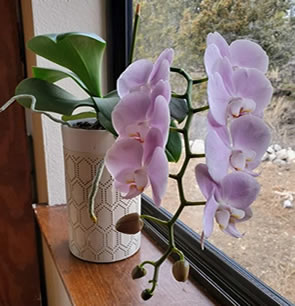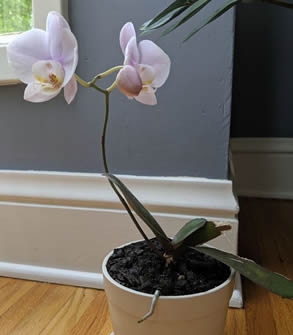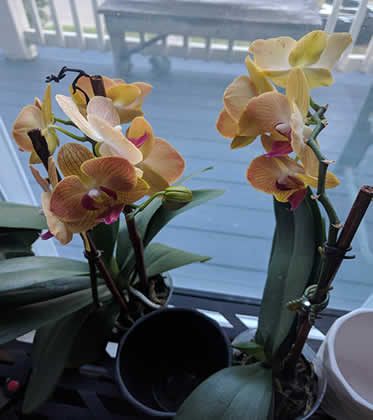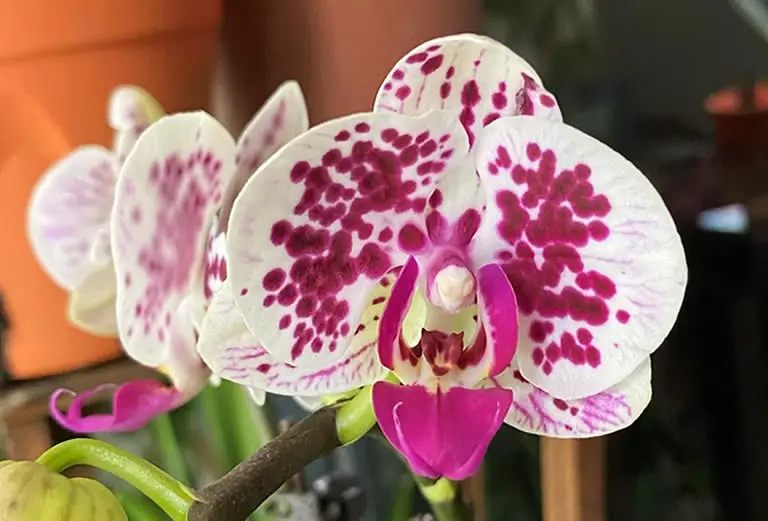Orchids are perennial plants that will normally produce flowers at least once per year. However, it is common for a well-cared-for orchid to bloom twice, or more, within a 12 month period. In this article I give you 9 simple steps you can take to help your orchid achieve multiple blooms every year, or at the very least make it bloom twice per year.
Table of Contents
- Orchids Can Be Made To Rebloom
- 9 Steps For Reblooming An Orchid
- 1. Identify your species of orchid
- 2. Adjust the care routine to match the orchid species
- 3. Give the plant time to rest before attempting to rebloom
- 4. Prune your orchids – the secret sauce to forcing reblooming
- 5. Keep your orchids watered during the new growth stage
- 6. Maintain sufficient levels of bright, indirect light to encourage bud growth
- 7. Apply fertilizer every month to feed the newly forming flowers
- 8. Watch orchid temperatures
- 9. Understand when you should attempt reblooming & when you dhouldn’t!
- What to do with an orchid after the blooms fall off
Orchids Can Be Made To Rebloom
Orchids consist of 28,000 different species so it is no surprise that they come with a variety of different blooms. With so many different species you will not be surprised to learn that there is also no hard-set general care routine for an orchid, as each species has its own care requirements.
However, there are some very important things you need to consider when it comes to the care of this succulent plant as we outlined in our orchid care guide.
Luckily though, as you will see later, there are general steps you can take to make any orchid bloom more than once per year.
Orchids are perennial blooming plants that are very often assumed to be tropical, or subtropical. With so many varieties growing natively on Pacific islands and east Asia, among other tropical areas, this assumption is no surprise.
However, a number of very popular varieties commonly cultivated as houseplants, such as the very popular the Lady Slipper (botanical name Cypripedium calceolus), can be found growing wildly in northern parts of the United States and Eurasia and are therefore not tropical plants.
Likewise, due to the fact that a great many orchids require a similar care routine to succulents, many species of orchid are thought to be succulents.
Although a large number of orchid species do require similar care to succulents, they are not succulents.
The orchids that are native to the cooler climates tend to be more popular as houseplants and are sold more widely than their tropical and subtropical cousins simply because they grow better in American homes and are easy to care for.
Tropical and subtropical orchids need higher-than-normal humidity and warmth levels to be maintained.
In order to bloom multiple times per year while those orchids that are more suited to the climate and humidity levels of a typical US home.
These indoor orchids will find it easier to produce multiple blooms without any real concerted effort from you. Some will even bloom every 3 months.
Orchids naturally bloom only once per year
Although orchids are naturally perennials (plants that bloom once every 12 months) a well-cared-for orchid, of any variety, will usually bloom more than once per year.
A well-cared-for orchid is one that is given the ideal environment – heat, humidity, watering, fertilization etc. – based on its species.

Depending on the species an orchid houseplant that receives the correct care for its species can bloom from 2 – 4 times in a year.
Orchids produce truly beautiful flowers with no two plants producing exactly the same blooms. Many hybrid orchids exist that have flowers which display spectacular hues and color mixes.
But with some species only blooming for a mere week the enjoyment orchids give you can be short lived. For this reason many orchid owners take steps to force their plant to flower more than once per year.
To learn how long you can expect your orchid to stay in bloom, and to see which orchids produce blooms that last the longest (some bloom for up to 4 months), read our article on how long do orchid blooms last. That article also shows you how to make each bloom last longer.
If you have an orchid that has bloomed already this year, or one that regularly blooms only once per year, but found that the bloom time went by far too quickly, you will likely be eager to get your houseplant to rebloom. However you probably have no idea how to go about doing it.
So, how do you get an orchid to bloom again?
The key to getting an orchid to bloom again is to give it the correct care for its specific species. Different orchid species have different care requirements.
On average, to trigger an orchid to rebloom first let it rest for a few weeks after blooming has completed. Then you should prune the plant, water it and apply the appropriate fertilizer.
After the orchid has been allowed to rest, water it once per week.
Provide the plant with 12 hours of bright indirect light – use a grow light if natural light is scarce.
Apply fertilizer once or twice monthly to encourage new growth.
9 Steps For Reblooming An Orchid
Here’s the 9 steps I recommend you follow to make an orchid rebloom in nine simple steps:
- Identify your species of orchid.
- Adjust your care routine to match the needs of the specific orchid species you own.
- Allow the plant to rest for a few weeks once blooming has completed.
- Prune the plant.
- Maintain a healthy watering routine.
- Ensure the plant is getting enough of the correct type of light.
- Fertilize the plant regularly to encourage bud growth.
- Regulate the temperature.
- Understand when it is safe to make an orchid rebloom.
Let’s look at each of these steps in closer detail.
1. Identify your species of orchid
When you want to get an orchid to rebloom, by far the most important consideration is knowing the species of the orchid.
You see with over 28,000 orchid species, many of which are hybrids, some of which are tropical or subtropical, and some of which are domestic or suited to domestic growing, there are different care requirements for different orchid species.
For example, orchids that are native to parts of Europe and America will require different care to orchids that are tropical and subtropical. For instance, tropical orchids will require you to take special steps to increase the humidity around the plant (by using terracotta pots, or water and pebble filled trays, for example) while orchids that grow in cooler climates will require no additional humidity care at all.
Once you identify the specific species of orchid that you want to make rebloom you can adjust your care routine appropriately to give the plant the attention it needs and ensure the environment in which it is growing is the most beneficial for the plant.
2. Adjust the care routine to match the orchid species
Although there are specific steps you can take to help encourage reblooming (as outlined below), simply giving your orchid the correct care it needs based on the requirements of its species is usually more than enough to ensure at least twice yearly houseplant blooms.
When you meet the care requirements of your particular orchid species, and you also follow the additional guidelines given below, you can expect 3 or even 4 blooms within a 12 month period.
3. Give the plant time to rest before attempting to rebloom
Before you use the additional steps outlined below make sure you give your orchid time to rest.
After blooming has completed an orchid will naturally go into a stage of dormancy. During dormancy the plant will rest and gather resources for its next growth cycle. Normally this last between six to nine months but you can shorten this stage.
However, you must allow your orchid to have at least 3 – 4 weeks of rest before start to encourage new growth as outlined below. During those weeks do nothing but water your plant (more on this later).
Once the orchid has been allowed to rest for a few weeks you can start to encourage new growth.
4. Prune your orchids – the secret sauce to forcing reblooming
Orchids, just like any other houseplant, only have so much resources available to them. A lot of those resources are expended on blooming. So you don’t want your orchid to continue using resources to support growths that are not producing flowers – you want those resources to be dedicated to reblooming.
Thus, once the blooming period ends and the plant has rested, the first thing you want to do is grab some sharp clean pruning shears and trim your plant.
Orchid stems are known as spikes. On a green spike, find the leaf node, which is the swollen area on the stem where a leaf emerges. Then, cut the stem an inch above the leaf node.
If the orchid stem has more than one leaf node, trim the one nearest the lower flower on the stem.

For brown stems, you can remove the whole stem from the orchid base as the spike is dead. Some orchid species such as Phalaenopsis won’t rebloom if the stems are brown, so you don’t want any of these left on your plant.
Now, in some instances, you might notice a double stem or a double spike on your orchids. In this rare occurrence, you want to trim the entire stem about an inch over the leaf node nearest the plant’s lower flowers. For the other stem, cut it at the base like would for a brown stem.
5. Keep your orchids watered during the new growth stage
After flowering has finished you can consider your orchid to be in a state of dormancy. What’s more, your orchids might go dormant in the spring when the rest of your indoor garden is coming to life. It happens!
Despite that your orchid isn’t actively growing or producing buds for blooming when it enters dormancy, it still needs care – though greatly reduced care.
Dormancy is a time for the plant to rest and gather up much needed resources for its next growth cycle. As I stated earlier, dormancy usually last between 6 – 9 months and although the steps outlined here will force an orchid out of dormancy much sooner the plant must be given at least 3 weeks to rest after blooming has completed and all the flowers have fallen off the plant.
This means all you should do after blooming has completed, for 3 – 4 weeks, is water the plant!
Orchids require less watering during dormancy. Only when the top layer of the orchid’s soil feels dry to the touch, is it time to replenish its pot with water.
That said, don’t let your orchids get too dry even during dormancy. This will definitely hurt your plant’s chances of reblooming.
You will know when it’s time to water the plant when the top layer of soil dries out. Don’t worry, although the soil looks completely dry there will still be moisture in the lower layers. You will likely need to water the plant only once or twice during this 3 – 4 week rest period as the orchid will require less water while not actively growing.
Water your orchids from the bottom by placing them in a sink or container filled with a few inches of water for about 20 minutes. The soil will soak up moisture. Allow the pot to drain completely before placing the orchid back in its normally location – you do not want your orchid to sit in water for long periods.
Once the plant shows signs of new growth return to your normal watering routine.
6. Maintain sufficient levels of bright, indirect light to encourage bud growth
12 – 14 hours of bright, indirect sunlight is required for orchids every day, whether they’re blooming or not.
Unlike many other plants, you do not need to change the amount of light your orchid is receiving when it is dormant and it can even be given slightly less light. However, you certainly don’t want to increase its light.
Make sure the plant is not placed in an area that gets strong direct sunlight. That’s a good way to burn the spikes, foliage and flowers. Injuring your plant by burning it will also inhibit reblooming.
When you want the plant to rebloom you must ensure it is getting at least 12 hours of good indirect light per day. Using a small grow light can encourage the plant to enter a new growth cycle if th natural light around the plant is less than ideal.
7. Apply fertilizer every month to feed the newly forming flowers
Once the orchid leaves its short dormancy phase it can use some extra juice in the tank to begin the reblooming process, so feel free to feed your plant.
At least once per month (but no more than twice per month), apply a properly balanced liquid plant fertilizer. If you intend to use a regular liquid houseplant fertilizer then please use it only at half-strength. Whatever the product instructions tell you to use, instead use half that much with the same amount of water.
Alternatively you can use a weaker succulent 20-20-20 liquid fertilizer, like these ones, without having to worry about changing strength quantities – just follow the advice on the label.
Having said that, the best way to feed an orchid is to use a dedicated orchid fertilizer as this will provide the plant with everything it needs in exactly the right quantities and strength.
Always use your fertilizer in the same water you use to hydrate your orchid. This is why I recommend using liquid feed as it easily dissolves in a sink of water, though there are very good soluble sprinkle feeds on the market as well (Miracle Gro makes a very good one for orchids as well as mist and liquid feeds).

Remember, if you choose to use standard plant feed then you absolutely must dilute the feed. If you don’t dilute the fertilizer, it will almost certainly be too strong for your orchids. When this happens your orchids will develop fertilizer burn on their foliage – this is just as detrimental to the long-term health of your plant as it sounds and will greatly restrict the plant’s ability to rebloom.
Be aware though that you don’t want to dilute the fertilizer too much, as then it might not be effective enough to trigger reblooming. This is why I recommend using a fertilizer formulated specifically for orchids instead of a regular plant food or even a succulent feed.
8. Watch orchid temperatures
By day, orchids are happy in temperatures of around 70°F (the typical temperature of an American home) and by night, temps of around 65°F.
Although most houseplants don’t react well to temperatures colder than their comfort range, that’s not the case for orchids. These flowering indoor plants can withstand short-term exposure to temps as low as 55°F, so don’t be afraid to expose your orchids to a bit of coolness at night if temperatures tend to dip. After all, the cold temps are integral in allowing stems to grow anyway. It’s from those stems that flowers will emerge.
However, the plant only needs cold temps until the stems or spikes develop. Once that happens, try to keep temps no lower than 65°F if possible.
A word of caution: do not place your orchid where there are drafts or sudden changes in temperatures. Although these plants do have a fairly high tolerance for cold and heat they do not like fluctuating temperatures. Keep your plant away from drafty doors that open to the outside of your home and away from fridge and freezer doors. Likewise, avoid placing the plant near heating vents or radiators.
9. Understand when you should attempt reblooming & when you dhouldn’t!
The temperature is not the only important consideration when attempting to rebloom orchids.
The time between when your orchids last bloomed and when you want the plant to rebloom is also to be factored in. I know that I have mentioned this already in several places but it is of such importance I must reiterate the point.

Orchids need a while to recover before they’re ready to rebloom. The plant most be allowed at least a short period of dormancy before you attempt to force reblooming.
If your plant has just finished blooming, trying to trigger reblooming right away is a recipe for disaster. It will weaken your plant and lead to lack-luster blooms – if the orchid blooms at all.
Instead, just for a few weeks (3 – 4), focus more on the plant’s dormancy care (just watering it) before embarking on the reblooming steps outlined above.
What to do with an orchid after the blooms fall off
I am often asked what steps a orchid houseplant owner should take when the plant finishes its blooming cycle once the blooms fall off the plant.
When the blooms fall off an orchid the plant has begun to enter a stage of dormancy. All you have to do at this point is to continue watering the plant (though less often). It does not need to be relocated.
Although dormancy will usually last between 6 – 9 months you can take steps to force an orchid to exit dormancy earlier so the plant will rebloom in the same year.
Normally you need to do nothing when the blooms fall off an orchid. Although the plant is getting ready to enter a stage of rest, that can last up to nine months, you do not need to take any additional steps at this stage of the plant’s growth and rest cycle.
Unlike many other plants, that require darkness during dormancy, an orchid will be quite happy to stay in it’s normal spot while it rests.
Although dormancy can last up to nine months there are steps you can take to reduce this rest time so that your orchid blooms again more quickly than usual.
Just follow the advice given in the earlier sections of this article and you can see your orchid bloom from 2 – 4 times every year instead of just once.

